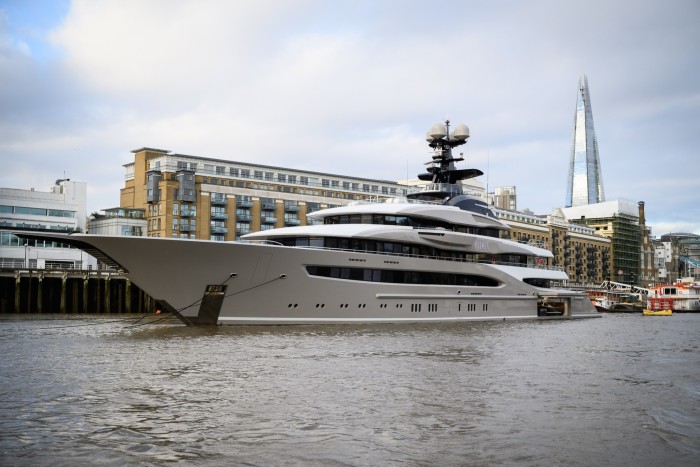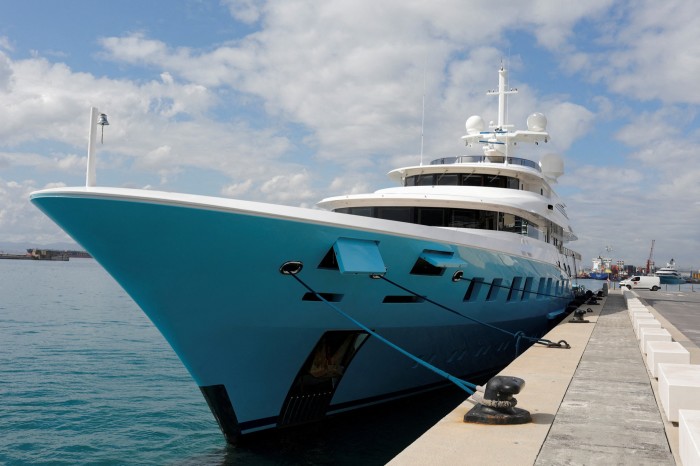Nasty surprises lurk for the ill-advised superyacht buyer

Roula Khalaf, Editor of the FT, selects her favourite stories in this weekly newsletter.
The purchase of a luxury item — whether it’s a diamond, a Gauguin, a superyacht or a private jet — is a pretty exhilarating prospect for most people, so it is not difficult to imagine how the duller aspects of due diligence and tax considerations might be overshadowed by the excitement of the moment.
But, as the transactions necessarily involve very large sums, they can prove unexpectedly costly in tax or customs terms if the right questions — and there are a lot of those — are not asked at the right time. Not checking the VAT status of a £100mn yacht before it re-enters European waters is a big mistake when the tax rate is 20 per cent.
Buyers of superyachts, which typically travel between jurisdictions but may remain in them for extended periods, can be particularly vulnerable to nasty surprises if they are not well-advised, warns John Leonida, a former specialist superyacht lawyer and now an independent consultant.
“I tell people to think of a yacht as floating real estate, as if they were buying a house or chalet, where they would expect a whole process of funding, ownership structure, tax considerations and so on,” he says. “But, over the years, I was involved in many cases where people were so keen to buy, and so caught up in the euphoria of becoming a yacht owner, that they didn’t tick all the boxes.”
Where tax is concerned, that can spring out of a very human willingness to hear and run with the headline good news, without ensuring the necessarily robust due diligence is carried out.
“There is often a narrative in this world that ‘tax is optional’ or ‘the yacht is owned by an offshore company, so it doesn’t really have any tax implications’,” continues Leonida. “People don’t realise that tax, from all sorts of angles, arises from where the ultimate beneficial owner lives, how the yacht is used, where it’s moored.”

Nic Arnold, UK head of JTC Private Office, says that the tax considerations involved for the purchasers of superyachts revolve, in part, around the tax regime where the owner is resident. “We have to stand back and look at it from the perspective of the owner, and consider the tax system they are embedded in,” she says. “That will drive the right answer for the ownership structure — and it absolutely won’t be a case of one size fits all.”
Issues around indirect taxes and levies such as VAT and customs duties on the asset itself can be even more variable, complex and easily misinterpreted, depending on how the asset is bought or sold and moved around.
VAT is a particularly slippery fish for prospective buyers. A superyacht may be labelled as VAT-paid, which is an attractive proposition if you are otherwise looking at 20 per cent tax on yachts often valued at anything between £5mn and £100mn plus. But that is not a reason to bypass due diligence into the history of its tax profile.
‘’Owners fundamentally need to understand the tax status of a vessel they are about to buy,” says Arnold. Its VAT-paid label means that, at some point in the past, someone paid EU VAT on it. But it’s a misleading term, as yachts enter and leave the EU, and can also switch between commercial and private use — events that could cause them to change or lose their VAT status.
“Has this yacht historically ever done anything other than be imported once into the EU, then sailed around the Mediterranean as a private vessel? Most don’t have this straightforward profile,” she explains. “If the one you’re looking at doesn’t, then you need to be clear whether any of its history has changed its tax status such that it no longer actually has a simple VAT-paid position and, in fact, requires its VAT status to be renewed.”

Brexit has imposed new obstacles for British citizens, creating the risk that moveable assets will be hit by VAT. But there is a useful EU tax relief that has become available to British residents wanting to sail their yacht in the Mediterranean — or possibly bring art or luxury items into the EU — in the shape of ‘temporary admission’. This basically allows non-EU owners to take a holiday cruise, or bring in art for a temporary exhibition, for example, without having to pay import duty on the asset. It’s simple, bona fide — and becoming increasingly popular, says Arnold. However, there are strict parameters to be observed, which owners should not take for granted.
“Private yachts cannot stay longer than 18 months, so temporary must mean temporary,” Arnold continues. “And this is a concession to non-EU holidaymakers, so you can’t charter out your yacht or lend it to European friends under this rule. The customs authorities won’t be happy if they come on board — as they will — and find a load of EU nationals in residence without the UK owner on board.”
Wherever you’re sailing, it’s also important to be aware of added complexities if works of art are housed on board. As Leonida points out: “It’s often the case that art on yachts is not owned by the entity that owns the yacht. It may be owned by an individual, or perhaps another trust.”

Again, that means standing back and considering how a customs official might view the situation. If the art has a different owner from the yacht, then that needs to be clearly proven and you should be able to show who has given permission for that art to be on board.
“It may sound like overkill, but customs officials will want to see that evidence, and also evidence of its tax status, which is likely to be completely different from that of the yacht,” warns Arnold.
She gives the example of an occasion where her clients were completely convinced that there was no tax issue in keeping an artwork on their yacht because it was flagged out of the Cayman Islands and therefore the art remained in the jurisdiction of the Caymans rather than the EU. “This proposition was put forward with such confidence that I had to phone a colleague to double-check [it],” Arnold says. “The clients’ story wasn’t true, of course, but it shows the degree to which people need to cross-check the information they’re given and consider where it has come from when relying on it: those clients could have lost their art — or at least be paying a lot of tax on it.”
As well as raising tax complexities, art on yachts may also spark potentially contentious issues around authorisations and export licence requirements. Arnold points, for example, to a regulation introduced by the EU in 2019 in an effort to combat looting from war-torn regions of the Middle East and elsewhere, requiring proof of the provenance of imported antiquities and sculptures.
“Whether it’s art, or yachts or planes, it all comes down to having the right paperwork — and that paperwork needs to align with the tax rules, regulatory rules and any industry-specific rules you’re trying to meet,” she says.
This is where high-quality and reliable advisers can come into their own. Ben Santamaria, a partner of owners’ representative business Tyburn Partners, deals with successful business people who want to become superyacht and private jet owners.
“They don’t necessarily know the right questions to ask, if it’s around an asset class that isn’t within their area of expertise — but they know the right people who will know and ask those questions on their behalf,” he says.
Arnold agrees. “Owners and their family offices need to raise the governance bar by knowing what questions need to be asked,” she says.
“There is not high transparency around the rules on moving these assets around the globe or operating them commercially, and they are detailed and complicated — so the owner may not be fully au fait with the tax sensitivities that go along with owning their yacht.”
But, even when they know the rules, the extent to which they worry about them can vary.
“Some clients are very cautious and take a lot of advice around how movement and use of the boat might affect their tax considerations,” says Santamaria. “Others just want to use the asset and — if there is a tax due — they will pay it.”
Superyachts: the key questions

John Leonida advises prospective superyacht owners to seek answers to the following questions:
What is the presumed tax status of the yacht — is it VAT-paid or not?
If it is said to be VAT-paid:
How was it used previously in its lifetime? Was it chartered or used privately?
Did it spend significant time outside the EU?
If so, how did it leave the EU? Were the appropriate declarations made on its departure and return?
How were the VAT returns dealt with? Was VAT at any point paid and then reclaimed?
If no tax has been paid on the yacht:
Who will be onboard — will friends or family be using her?
Will she be chartered?
Where will she be at all times?
How will you fund the upkeep?
Where the boat is flagged is generally less important than where it is used, although if you are British, with a British flag, and are not based in the EU, you can take advantage of the temporary importation regime. “It’s all about how you’re going to use the boat, and that determines the budget as well,” says Leonida.
This article is part of FT Wealth, a section providing in-depth coverage of philanthropy, entrepreneurs, family offices, as well as alternative and impact investment
Comments